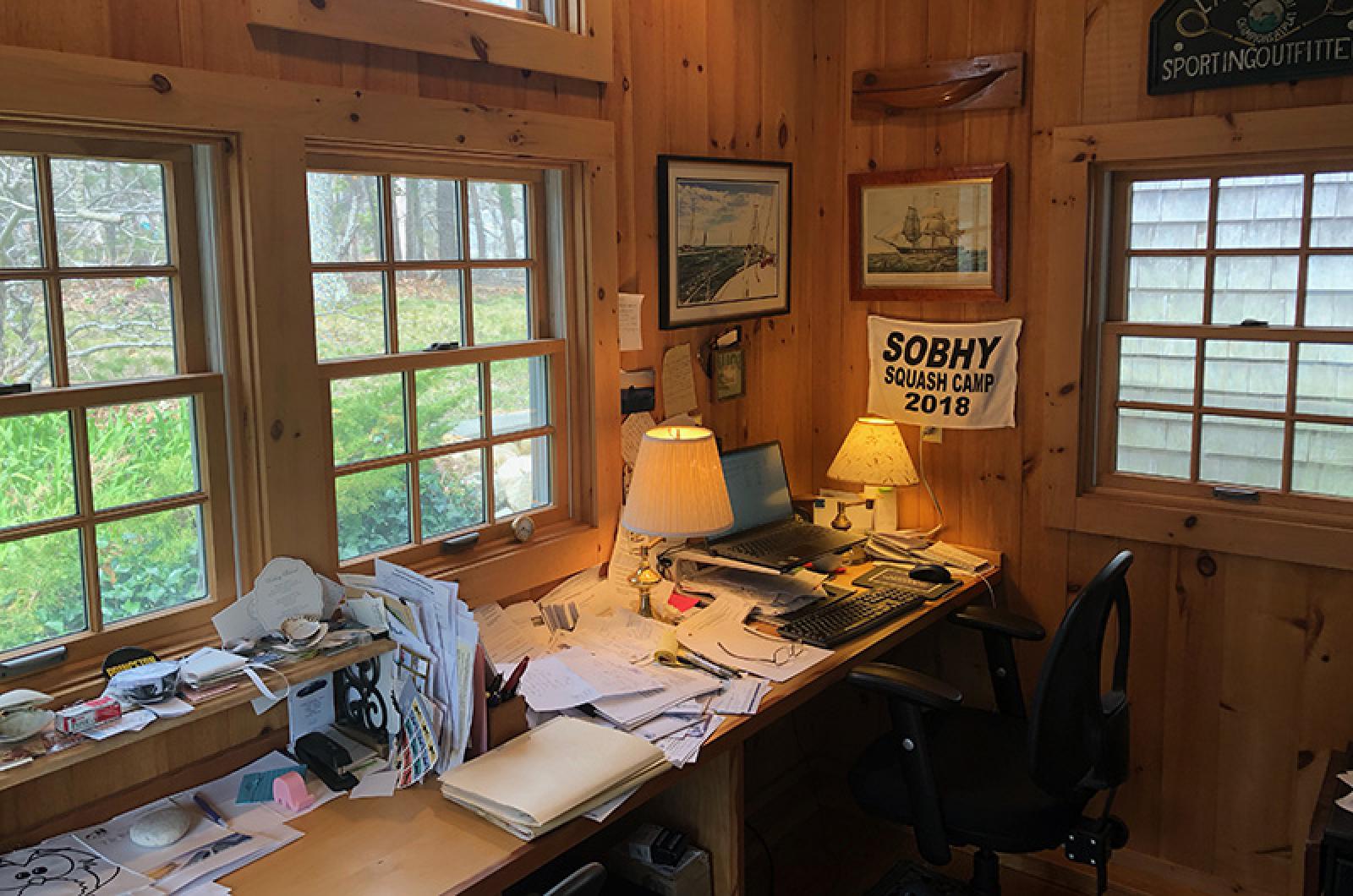The room where I write is actually my office. I love my office. It is back behind the garage in a space that used to be filled with rusted cans, rakes, shovels, old hoses, a wheel barrow and grass seed, and smelled of gasoline, oil and dirt. The floor was hard-packed soil, and termites had eaten their way into the southwest corner, leaving tiny mud pyramids of dark dirt and dust. That’s what it looked like when I first pried open the door and looked at that neglected section of the garage for the first time.
It reminded me of the garage I played in as a child. We called it The Barn. It had large, sliding doors with transom windows that suffered numerous traumatic assaults from my tennis practice. The Barn had three bays and held relics from my father’s life. A 12-pound shot that he used to win the NJ state shot put title while in high school, wooden-shafted golf clubs, half-hulls, a pair of boxing gloves, and his current love-car, which changed every few years.
He had an eye for classic cars: the 1959 powder blue Mercedes 190 SL with the ivory steering wheel, Blaupunkt radio and convertible top. The white 1959 Austin Healy with an overdrive button on the dashboard I was afraid to push. The Singer convertible roadster with the steering wheel on the right-hand side and a wooden frame that one day broke, sending a rear wheel hurtling past us and down the street.
The Barn was a magical place that revealed new secrets each time I rolled back its giant, rumbling doors. Everybody needs a place with secrets and a place they can tell their secrets to.
When I decided to convert my current garage space to an office, I hired the carpenter who had created the magnificent great room in our house. His company was This Whole House. His name was Scott Graupner. He loved the blues and the Rolling Stones, dreamed about finishing the home he was building in Maine and was a superb finish carpenter.
I wanted the office to have the same feel as the Great Room. That meant random-width, rough-sawn pine boards on the walls, boxed collar ties in the ceiling, yellow pine floor and a built-in, hand-made desktop built along the northern, gable-end wall. The desktop was long enough for two people to sit at with a cubby underneath for the printer.
Sitting at my place in the northeast corner, I can look out the window and watch the rays of the setting sun weave through the pine and scrub oak behind the building. In the spring I watch the orange tiger lilies come into bloom, and in the fall I see the sun march to the west as the days grow shorter. (This afternoon, as I write this, it is snowing and I watch the snow fill up the branches and feel quite cozy and safe inside.)
The walls and bookshelves are filled with the flotsam of my own life. They constantly stir my memory and give comfort just by being there. Above my head in front of me is a large framed photo I took during the 2015 Figawi race to Nantucket from the bow of the boat I was crewing on (Trinity). The fleet was on a broad reach and 17 of the 200 boats in the race are splayed out across the horizon in front me, straining forward on a rich, blue-green sea that had suddenly been lit up by a burst of sunlight. I took the picture and seconds later that rich color was gone. I felt like I had caught lightning in a bottle.
To my right, pinned to the wall, is a small banner that reads “Sobhy Squash Camp 2018.” It is a reminder of how I survived three days of intensive squash training in Baltimore with 16-year-olds, middle-agers and one other senior in preparation for the World Senior Masters Squash Championships, which was to be held in Charlottesville, Va, that summer. I was so tired the first night after training, I was afraid to go to sleep for fear I wouldn’t wake up.
To my right on the wall is a half-hull and a print of a Napoleonic era, three-masted ship of the line Windsor Castle. Behind me are bookshelves with pictures of my children when they were young, office supplies, and a poster from 1983 the French Open which I covered for World Tennis magazine and watched the first Frenchman in 37 years, Yannick Noah, win the title. It was the last time any Grand Slam tourney was won with a wooden racket.
Next to the door, sitting on a small file cabinet is a wooden pond yacht. Years ago, when I mentioned to my fiance that I owned a pond yacht, she later said how she had looked forward to sailing on it and was so disappointed to learn that it was a foot-and-half long.
On the wall above it is an etching of a working lake shack, with an aged, balding man standing in the center, a damp rag or hat in his right hand. It is signed by Lionel Barrymore, the famed actor who wanted to be an artist, but was pushed by his parents into the family business.
Scott finished the office in 2007 and I am eternally grateful. He created a special place that is a true refuge and where I have written contracts, social media, blog posts, personal essays, thank-you notes, articles about Holmes Hole races and a eulogy for my mother who is buried in Vineyard Haven. They say writing is a lonely endeavor. But that’s not true, not when you have a sacred, vital space to pursue it in.
David Lott lives in Vineyard Haven.




Comments (5)
Comments
Comment policy »